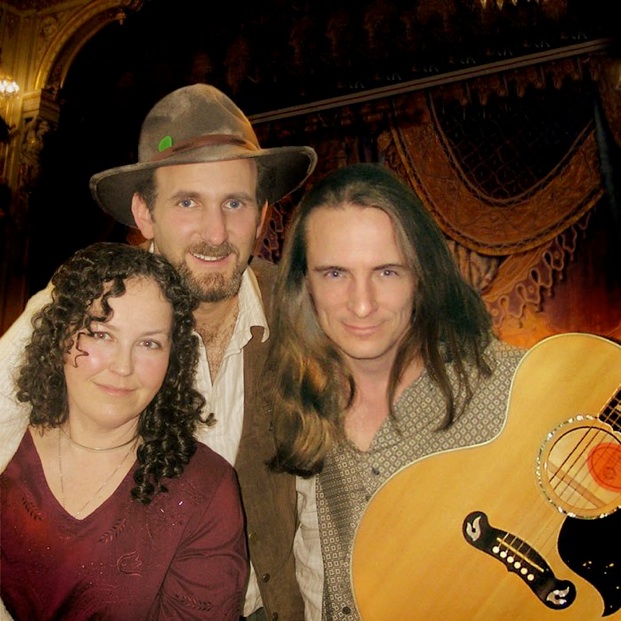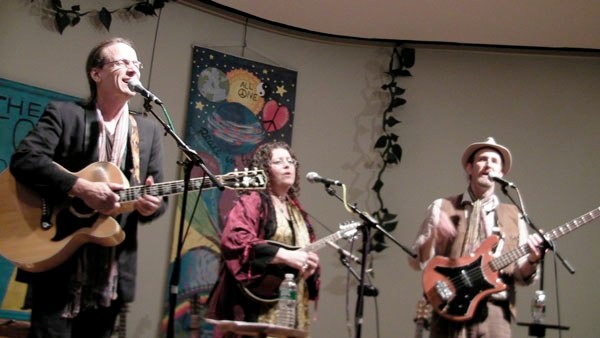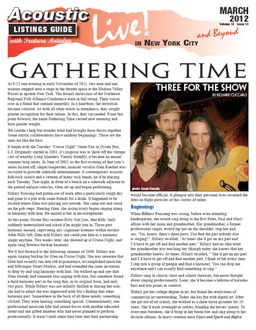Gathering Time
Three for the Show
By Richard Cuccaro

At 9:15 one evening in early November of 2011, two men and one woman stepped onto a stage in the theater space at the Hudson Valley Resort in upstate New York. The formal showcases of the Northeast Regional Folk Alliance Conference were in full swing. Their voices rose in a blend that seemed unearthly. In a heartbeat, the terrestrial became celestial. As with all other artists in attendance, they sought greater recognition for their talents. In this, they succeeded. From this point forward, the name Gathering Time carried new meaning and bore greater weight.
We couldn’t help but wonder what had brought these forces together. Some artistic collaborations have unlikely beginnings. Those are the ones we like the best.
It began with the Tuesday “Cruise Night” Street Fair in Oyster Bay, L.I. Originally started in 2003, it’s purpose was to show off the vintage cars of wealthy Long Islanders. Family friendly, it became an annual summer-long series. In June of 2005, as the first evening of that year’s series kicked off, singer/songwriter, monster vocalist Glen Roethel was recruited to provide sidewalk entertainment. A contemporary acoustic folk/rock soloist and a veteran of many rock bands, he’d be playing each Tuesday. That night, in front of a bench on a sidewalk adjacent to the parked antique vehicles, Glen set up and began performing.
Hillary Foxsong had gotten out of work after a particularly tough day and gone to a pub with some friends for a drink. It happened to be located where Glen was playing just outside. She came out and stood on the pub steps. Hearing Glen, she instinctively began singing along in harmony with him. He smiled at her in encouragement.
At this point, Oyster Bay resident Billy Joel (yes, that Billy Joel) suddenly materialized and asked if he might join in. Three-part harmony ensued, captivating any cognizant listeners within earshot. After Billy left, Glen told Hillary she could join him as a harmony singer anytime. Two weeks later, she showed up at Cruise Night, and again sang flawless backup harmony.
We’ll fast-forward to the following summer of 2006. Hillary was again singing backup for Glen on Cruise Night. She was unaware that Glen had recently run into old acquaintance, accomplished musician and folksinger Stuart Markus, and had extended the same invitation to drop by and sing harmony with him. Stu walked up and saw that Glen already had someone else singing with him, but somehow found a third harmony part in the song that, in its original form, had only two parts. While Hillary was not initially thrilled at sharing her role, she had to admit she was impressed with Stu’s finding that other harmony part. Somewhere in the back of all three minds, something clicked. They were hearing something special. Unintentionally, one professional musician lifer had joined forces with another educated talent and one gifted amateur who had never planned to perform professionally. It wasn’t until some time later that their partnership would become official. A glimpse into their personal lives revealed the fates-in-flight particles of this vortex of talent.
Beginnings
When Hillary Foxsong was young, before even attending kindergarten, she would sing along to the first Peter, Paul and Mary album with her mom and grandmother. Her grandmother, a former professional singer, would tap her on the shoulder, stop her and say, “No, honey, there’s three parts. You find the part nobody else is singing!” Hillary recalled, “At times she’d get on my part and I’d have to get off and find another part.” Hillary had no idea what her grandmother was teaching her (though today she knows that her grandmother knew). At times, Hillary recalled, “ She’d get on my part and I’d have to get off and find another part. I think of her every time I step into a group of people and find a harmony. You can drop me anywhere and I can usually find something to sing.”
Hillary sang in church choir and school choruses, but never thought about singing professionally. Later, she’d become a habitue of karaoke bars and win prizes in contests.
Hillary got her college degree in art, but found the restrictions of commercial art unrewarding. Today she has fun with digital art. After she got out of art school, she worked as a show horse groomer for 10 years. She’d work overnight in stables, braiding the horses’ manes. To overcome boredom, she’d bring in her boom box and sing along to her favorite albums. In heavy rotation were Court and Spark and Hejira by Joni Mitchell, Ingenue by k.d. Lang, Diva by Annie Lennox and Lyle Lovett’s Joshua Judges Ruth. Depending on her mood, she’d sing harmony or straight melody. Today, she says, “I can sing every song on those albums. Numerous other tapes of classic folk/rock helped to add to her encyclopedic repertoire. Aside from karaoke, until meeting Glen, there the matter rested.

In Rochester, where Stuart Markus grew up, Stu’s parents always encouraged his musical pursuits. They enrolled him in a Yamaha music program for kids when he was around six years old.
Vocal harmony made its first impact when a visiting uncle brought Simon and Garfunkel’s Bridge Over Troubled Water. When he was 11 or 12, he heard Crosby, Stills and Nash singing “Suite Judy Blue Eyes,” and again was impressed with their harmony. That impact would prove to be prophetic.
Stu started taking piano lessons when he was six or seven. His grandparents gave him a guitar for his eighth birthday. After a “good” piano lesson his piano teacher would teach him a couple of new chords on the guitar. In fourth grade he started French horn lessons, but continued playing guitar. He said that he got guitar lessons in “dribs and drabs.” There were group lessons in fifth grade and whenever possible, he hung out with players better than him, knowing it was a good way to improve his own playing. That said, out of all the instruments he’s studied (drums included), guitar is the one on which he’s most self-taught. Stu participated in chorus throughout middle school and high school, but that was just the tip of the iceberg.
While still in high school, he also took voice lessons and music theory classes for two years at the Community Education Program at the Eastman School of Music, part of the University of Rochester. In his senior year of high school, the new music teacher formed a jazz choir and Stu joined that. They did Manhattan Transfer style arrangements of swing standards and jazz became another genre Stu came to love.
At the University of Pennsylvania, he took more music theory classes and played French horn in the marching band and wind ensemble and sang in the University Choir and several a-cappella groups. He eventually became president, musical director and arranger (all at the same time) of the nine-voice a capella group Chord-On-Blues.”
After college, Stu moved to Brooklyn (N.Y.) and formed an a capella group, The Broadway Local which lasted for two years. He’d go to parties and hang back, too shy to converse. However, he’d always bring his guitar along. Someone would say, “Hey, Stu, why don’t you play something?” He’d play and sing and everyone would sing along to covers he’d learned. With music as an icebreaker, he began making friends and realized that he knew a lot more songs than he’d thought at first. He didn’t care for the term “folksinger” at first, not realizing how broad a term it was. He preferred “rock and roll singer/songwriter” who preferred using an acoustic guitar.
After four years in Brooklyn, Stu moved out to Long Island and kept going to parties with his guitar, making more friends along the way. After a couple of years, he discovered that there were people who were making money playing out in bars, some of them less talented than he. He bought a sound system and started playing in bars and restaurants. From 1992 to 2006, Stu was primarily a “covers guy “ who wrote a song here and there, but only occasionally slip them into a restaurant gig. He met Long Island singer/songwriter Judith Zweiman and they began backing each other up on originals and covers. Stu and Judith then forayed into singing sea chanties as the duo “Strike The Bell.” That was his introduction into traditional music. His website also informs us: “A lifelong small boat sailor, … his love of sea chanteys has grown out of his love of sailing.” Another factoid found online, not covered in our interview: “Stuart has also organized several high-profile benefit concerts, most notably the [annual] ‘Just Wild About Harry’ Chapin tribute concerts by top Long Island songwriters. (To date the concerts have raised over three tons of food.)” Stu is still the organizer for this benefit.
Glen Roethel can remember records being played when he was just 2. His family moved to Long Island when he was 6 and that’s where he grew up. His brother brought home some records when he was 6 years old — ‘60s girl groups (“Please Mr. Postman,” “Chapel of Love”) and The Beatles. Glen was enthralled and wanted to play music. At first he thought he’d like to be a singing drummer [Could be the “Ringo effect.” Remember… “What would you do if I sang out of tune?”]. This changed when he got the guitar at age 11. “Precocious “ doesn’t begin to describe Glen’s experience.
By the time he was 12, he had practiced enough to audition and get hired as lead guitarist by a professional band named Focus. They performed at parties, church dances, and school and town events. In time, Glen was negotiating contracts, recording, writing songs and developing marketing materials. Throughout high school Glen provided guitar, bass, piano and vocal on numerous musical projects, writing, recording, playing and producing. The progression from here seems encyclopedic. After high school, he played solo for a while, and then joined a local band The Passengers. He also joined a wedding band, Champagne that performed 130 events each year. Glen’s repertoire enlarged and spanned material from Manhattan Transfer and Sinatra to The Beatles and the Rolling Stones. His experience continued to grow with a stint in the Pat Nichols Band (a signed rock project) and his own “Buddha Babies” project. This fused Cuban, Peruvian, African/American players and styles. [!] In partnership with others, Glen also recorded award-winning children’s albums.
Glen had originally discovered the Folk Music Society of Huntington (FMSH) somewhere in the mid-’90s. He first met Stu back then at a sister organization called the Island Songwriters Showcase, a workshop group. FMSH was small and, given his involvement with rock and jazz, didn’t hold his interest for long. He lost touch with both FMSH and Stu. When he returned ten years later, FMSH had grown and become well organized and was the center of a huge music scene on Long Island. It was a community and that aspect of it appealed to Glen. He became a member and began attending open mics and concerts. He also began attending the Northeast Regional Folk Alliance (NERFA) Conference each fall. He still didn’t quite fit in, but wanted to learn more about the genre. Glen then ran into Stu and embarked on the current path when he extended the aforementioned invitation.

Gathering What?
Stu and Hillary joked that they kept showing up at Glen’s gigs to sing harmony and that he didn’t seem to mind, because he kept splitting up the tip jar. Glen quipped in return, that they kept showing up and stealing his tip money. They sang together often and were getting better and better. They decided that they needed a name and tried calling themselves “Third Wheel” until an Internet search showed that there were already other groups out there using it.
After they had been together for a while, Glen suggested teaming up at NERFA, thinking they’d go over well. Stu had already been attending for 10 years, but Hillary asked, “What’s a NERFA?” So, in November of 2007, they went and for Hillary it was a real eye-opener. Once formal showcases are over (around 11:30pm), the late-night guerilla showcases and non-stop jamming can draw a neophyte into a frenzied whirlwind. Stu and Glen agreed that it was a challenge to get Hillary to slow down and get some sleep now and then. Together, they performed in centrally located lounge areas and people began asking, “What’s your name? Do you have an album? Who are you? One presenter said, “If you can come up with a name, I want to book you.” Several DJs approached them and said “If you get something recorded, get it to me.” That was when the need for a group name became urgent. Remembering how people gathered around them at NERFA, they began thinking, “Gathering … something … Moss! (NO!) … Strength! (NO!) When Stu suggested “Gathering Time,” there was no immediate negative reaction anywhere, as with other suggestions (previously, at least one of them would “make a face”), so they went with it. It was akin to Jim Croce’s “Time in a Bottle,” a reference to the most precious commodity in life.
Stu had always wanted to record a version of Peter Yarrow’s “Light One Candle.” Now was the perfect opportunity. Under their new name, the recording was a success and got airplay in the U.S., Europe and Israel.
The following year they released their first CD, Songs of Hope and Freedom. It contained Hillary’s first songwriting effort, “Remember Me” as well as “Light One Candle” and a number of originals from Stu and Glen as well as one each from fellow L.I. songwriters Judith Zweiman and Josh Joffen.
Although songwriting was a new endeavor for Hillary, it didn’t grow out of a vacuum. She has been part of a community of online fiction writers for a number of years. On her website, along with her fiction, her imagination and creativity can be seen in her digital graphics as well.
Closer to the Present
During the 2011 NERFA conference, I picked up the sampler for their new album Red Apples and Gold. Hillary’s contribution, “If It Would Only Rain” is a real standout. We get a good look at her fiction-writing ability. The lyrics tell of a letter from a fallen Confederate soldier to his wife and her inner dialogue in response. There’s nothin’ Civil about war when it comes to the battle / Brothers kill brothers, men slaughtered like cattle / They say Jake was brave, he took three Yankees with him / But I think of their wives and I think of their children. Reprising what I wrote in the review section of our 2011 December NERFA Scrapbook issue: “It’s timeless, brilliant and heart wrenching. The writing and the song’s execution bode extremely well for this group.”
Gathering Time was chosen to perform in the formal showcases at NERFA 2011. Their set cleared the remaining cobwebs away from some eyes (mine included) and opened a bunch of others. Their rendition of “Suite: Judy Blue Eyes” blew everyone away. The smooth-as-silk harmonies were the equal of (and maybe better than) the original by Crosby Stills and Nash. Glen’s rock-honed falsetto on the line It’s my heart that’s a-suffering / It’s a-dying absolutely killed.
All three performers are constantly working these days, staying busy in between Gathering Time gigs. Both Stu and Glen still perform solo. Hillary is one-third of the Long Island group “The Folk Goddesses” with Martha Trachtenberg and Judith Zweiman. Stu also continues to perform with Judith in “Strike the Bell” when the opportunity presents itself.
Glen will sometimes perform in other configurations. He told me: “I recently had the honor of performing in concert with A Few Good Men - a Jazz ensemble comprised of three formerly incarcerated men from Sing-Sing prison, with the Director of Deutsche Bank on drums. A career in music is never boring.”
Their story illustrates a pet theory of mine about the singer/songwriter genre: It borrows from so many different musical areas that it’s possible for many fans of acoustic roots/folk/pop music to generally agree across wide swaths, but some fans may absolutely hate a favorite of a close friend. Why? The roots of an artist’s style (vocal or writing) has becomes old for some or perhaps was always annoying in its original form. However, it’s still a favorite for another fan. Did those borrowed Bo Diddley/Chuck Berry rhythms turn sour? Did those James Taylor/Michael McDonald-like vocals get too saccharine?
Whatever the sound Gathering Time brings to a listener, the band’s history reveals a voluminous repertoire that covers enormous stylistic ground. Each member has brought a huge storehouse of influences to bear on this group project. Their talents render it infinitely malleable. They might not overcome the particular tastes of certain people who hear roots they’ve chosen to keep distant, but they will bring many things to many people, hopefully for a long time.
Websites:
www.myspace.com/hillaryfoxsong
Gathering Time Gigs:
Mar 2 8:30pm Garden Stage @ UU Congregation, Garden City, NY
24 8pm Listen Live Music Inc. Old Zionsville, PA
31 8pm People’s Voice Cafe, New York, NY
Apr 15 7pm Piedmont Percolator Coffeehouse, Somers, CT
16 1:15pm Point Lookout Senior Ctr, Point Lookout, NY
29 2pm Pearl River Library, Pearl River, NY
May 8 7pm John Platt’s On Your Radar, The Living Room,
154 Ludlow St., NYC $12


